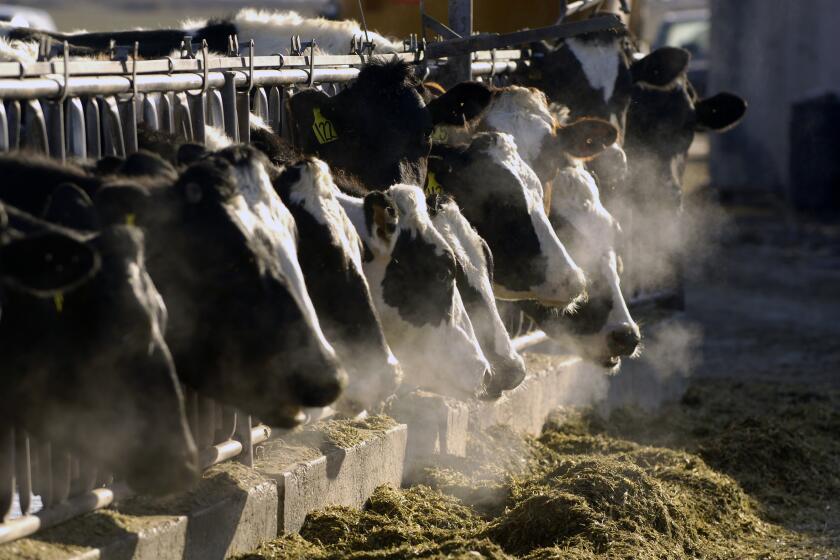U.S. Estimates 76 Million Food-Borne Illness Cases Yearly
- Share via
Tainted food sickens up to 76 million Americans and kills 5,000 each year, according to a sweeping government analysis released Thursday showing that food-borne illnesses appear to be far more common than generally believed.
The new study by the Centers for Disease Control and Prevention also estimates that 325,000 people are hospitalized annually for food-related illnesses.
Most striking, the total number of cases of food-borne illness in the study is more than double the last authoritative estimate of 33 million, made in 1994. The dramatic upward revision largely reflects better understanding of the problem and improved tracking of the occurrences, most of which go unreported, the researchers say.
Drawing on new disease-surveillance networks, death certificates, academic studies and previous government surveys, the researchers arrived at what they describe as the most complete picture yet of illnesses from food. Their estimates do not include illnesses triggered by contaminated water, which also causes millions of cases.
Though toxic chemicals and metals also carry disease risk, the report emphasizes the role of microbes in food-borne illness. About 13.8 million cases and 1,800 deaths were linked to 28 food-borne bacteria, parasites and viruses.
Among the pathogens causing the most cases are the bacteria Campylobacter (associated with contaminated, undercooked chicken) and Salmonella (transmitted by a variety of foods, including contaminated, undercooked eggs). Those two combined for 3.3 million cases annually.
But the single largest known contributor to food-borne illness, causing 9.2 million cases, is what are called the Norwalk-like viruses. Discovered within the last two decades, these are found in shellfish harvested from waste-polluted water and can be transmitted to food by unwashed hands.
There were 62 million cases and 3,200 deaths from food-borne illness of “unknown” origins, the researchers estimate. And most of those cases were also infectious, involving microbes that either go undetected or have not been discovered yet, said the study’s lead author, CDC infectious disease specialist Paul Mead.
“These new estimates confirm that while Americans have one of the safest food supplies in the world, food-borne illness is nevertheless an important public health problem in this country,” he said.
The study appears in the CDC-published journal Emerging Infectious Diseases.
The new estimate of annual deaths from food-borne illness is much lower than a widely cited figure from a 1987 study of 9,000, but much higher than the 522 estimated in a 1989 study.
The CDC analysis was not designed to measure whether such illnesses have risen or fallen over the years. But a CDC statement suggests that the aging of the population, the emergence of newly pathogenic microbe strains and other factors such as improved tracking techniques may have boosted the number of cases.
People should not be alarmed by the figures, he said, but perhaps should be more aware of measures to reduce the risk of transmitting food-borne disease. Those involve washing your hands, properly cleaning food and utensils, keeping raw meats apart from prepared foods, thoroughly cooking food to kill microbes and chilling it to retard growth of microbes.
Calculating the national burden of food-borne illness poses numerous problems. The vast majority of cases go unreported, experts say, if only because the primary symptoms are transient vomiting and diarrhea, which do not always prompt afflicted people to get a doctor’s help. Even then, doctors seldom conduct diagnostic tests to identify the exact cause. Nor do they report most diagnosed cases to state health authorities.
Such uncertainties led the CDC researchers to make certain assumptions and extrapolations that other experts will inevitably challenge.
Dean Cliver, a UC Davis professor of food safety, questioned the several million estimated cases attributed to Norwalk-like viruses. Very few cases of the transient gastrointestinal illness that the viruses cause are definitively diagnosed, he said.
Because these viruses were the leading pathogen identified, the overall estimate is also somewhat open to question, he said.
The CDC researchers acknowledge that problem but say there is good evidence showing that Norwalk-like viruses cause a substantial amount of acute gastroenteritis.
A primary reason that the new overall figure is more than twice the earlier estimate is recent data showing that acute gastroenteritis is more common than previously believed. In 1994, researchers estimated that there were 99 million cases a year, but the CDC team upped that to 211 million.
Based on clinical data, the researchers concluded that 36% of those cases--or 76 million--were caused by food-borne agents.
(BEGIN TEXT OF INFOBOX / INFOGRAPHIC)
Culprits in Food-Borne Illness
A comprehensive analysis shows that food-borne illnesses are far more common but somewhat less deadly than generally believed. Below are annual figures for the United States.
Disease or Agent: Bacterial, Campylobacter
Illnesses: 1,963,141
Hospitalizations: 10,539
Deaths: 99
Disease or Agent: Bacterial, Salmonella, non-typhoidal
Illnesses: 1,341,873
Hospitalizations: 15,608
Deaths: 553
Disease or Agent: Bacterial, Clostridium
Illnesses: 248,520
Hospitalizations: 41
Deaths: 7
Disease or Agent: Bacterial, Staphylococcus, food poisoning
Illnesses: 185,060
Hospitalizations: 1,753
Deaths: 2
Disease or Agent: Bacterial, Yersina enterocolitica
Illnesses: 86,731
Hospitalizations: 1,105
Deaths: 2
Disease or Agent: Parasitic, Giardia lambia
Illnesses: 200,000
Hospitalizations: 500
Deaths: 1
Disease or Agent: Parasitic, Toxoplasma gondii
Illnesses: 112,500
Hospitalizations: 2,500
Deaths: 375
Disease or Agent: Viral, Norwalk-like viruses
Illnesses: 9,200,000
Hospitalizations: 20,000
Deaths: 124
Reducing the Risk of Getting Sick
Symptoms of food-borne illness, which may appear from six hours to 10 days after exposure, include severe abdominal cramps, diarrhea, nausea, vomiting, dry mouth, double vision, difficulty swallowing, and flu-like fever, chills, headache and backache. Some food safety tips:
Clean: Wash hands, utensils and surfaces with hot, soapy water before and after food preparation and especially after preparing meat, poultry, eggs or seafood.
Separate: Keep raw meat, poultry, eggs and seafood juices away from ready-to-eat foods. Never place cooked food on an unwashed plate that may have held uncooked food.
Cook: Cook food to the proper internal temperature; use a food thermometer to be sure.
Chill: Refrigerate or freeze perishables, prepared food and leftovers within two hours and make sure the refrigerator is set no higher than 40 degrees F and the freezer is set at 0 degrees F.
Sources: Centers for Disease Control and Prevention, International Food Information Council.






